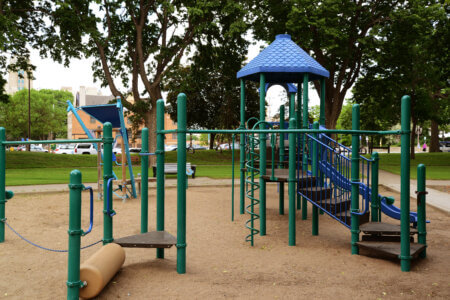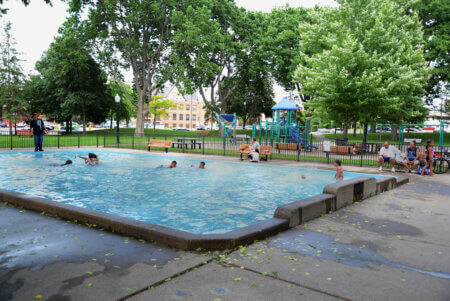Project Location
1000 E 14th St. Minneapolis, MN 55404
Location MapProject Manager
Emma Pachuta
Phone: 612-499-3711
Email: epachuta@minneapolisparks.org
Michael Jones
Phone: 612-499-7611
Email: mjones@minneapolisparks.org

Subscribe to Email Updates
Language Resources
Correo Electrónico: preguntas@minneapolisparks.org
Email: suaalo@minneapolisparks.org
Key Documents
Attachment A – Downtown Service Area Master Plan – Elliot Park [PDF]
Share your feedback for the Elliot Park improvements!
Share your feedback for the Elliot Park improvements! (Somali)
Status
Current Phase: Community Engagement
Anticipated Construction Timeframe: 2024-2025
NPP20 Funded: Yes
What's New
You’re Invited: Presentation on Improving Safety through Design
Lunch provided! Join the Minneapolis Park and Recreation Board (MPRB) and the East Town Business Partnership (ETBP) for a lunch-and-learn at the Elliot Recreation Center. We will discuss how real […]
Share your thoughts on upcoming improvements and safety at Elliot Park!
Online survey is now available Attend a public forum on park safety concerns on Thursday, March 7 Park Improvements and Safety With funding now available for an improvements project at […]
Timeline
Milestones (anticipated project schedule by month/season)
Winter 2023: Initial project scoping
Spring 2024-Summer: Community engagement with stakeholder and residents
Summer 2024: Determination of priority improvements for current funding
Get Involved
Subscribe to Email Updates
Enter your email to receive updates about meetings, events and more.
Upcoming Meetings
History
Name: The park and avenue were named for Dr. Jacob S. Elliot, who along with his wife donated the original land for Elliot Park in 1883. The Elliot’s son, Wyman, served as a park commissioner 1899-1901.
Acquisition and Development
Dr. Elliot had once resided in Minneapolis but had moved to California by the time the park board was created in 1883. Upon learning of the new park authority, he offered to donate as a park the land that had once been his garden. The park board accepted his donation of 2.18 acres in July of that year.
The park was quickly expanded when the Homeopathic Hospital offered to sell an adjoining two blocks of land to the park board for $20,000. The park board accepted that offer in December 1883. In the summer of 1884 the park board vacated 9th Street through the park and asked Horace Cleveland to create plans for the park.
The original plan included a pond in the center of the park. A water pipe was installed to the center of the lake in 1889, which produced a fountain of water that reached fifty feet into the air. The pond served as a skating rink in the early years of the park.
Nearly three acres were added to the park in 1908-09 for about $34,000. Negotiations for the land to the east and south of the original park took more than a year to complete.
With the addition of the new land Superintendent Theodore Wirth presented two plans for the park in the 1909 annual report. In both plans the one-time pond was shown as a wading pool. The plans differed in that one would have developed the eastern part of the park as a playground and the other plan called for a sunken flower garden. Wirth’s plans assumed the closing of 10th Avenue through the park, which had been approved by the board. However with improvement plans on hold, 10th Avenue was kept open by request of residents of the neighborhood.
Wirth’s playground option for the park was selected by the board for implementation in 1912, but after less than a year of operation, the nearby hospitals complained about the noise of children playing, and the playground equipment was removed in early 1913.
Although Wirth’s sunken garden was never created, even after the removal of the playground equipment, Elliot Park was planted with more flowers each year than most other parks. Elliot trailed only Loring Park, Minnehaha Park, Lake Harriet and the Armory Gardens in the number of flowers and bedding plants planted in 1919, with more than 4,000 plants.
As with most other parks, few improvements were made again until after World War II. In 1948, 10th Avenue was finally closed in preparation for a new playground, athletic field, tennis courts and wading pool, which were built in 1949. A shelter at the park was completed in 1950. The shelter was renovated in 1961.
In 1980, Elliot Park became the site of a unique project in Minneapolis parks. With the help of federal and state grants totaling nearly a million dollars, the first recreation center fully accessible to people with disabilities was built in Minneapolis parks.
The play areas in the park were updated in 1998, including a new basketball court, new pathways and landscaping. A skateboard park was added to the park in 2004.
Internet-enabled thermostat controls were installed in the rec center in 2008 to improve energy-efficiency and reduce operating costs. Security cameras were also installed that year.
In 2010 one of the first Nice Ride bicycle rental kiosks was installed at the park.
In 2015 a new synthetic turf athletic field replaced the battered grass field that had fallen into disrepair. The new field is larger, sporting NCAA-regulation dimensions (70 x 115 yards). Neighboring North Central College contributed a significant portion of the field’s construction cost and its men’s and women’s soccer teams host home games there.
History through 2008 written by David C. Smith, with updates from 2009 to present written by MPRB.
Background
Background
The Elliot Park Playground and Park Improvements planning work will build upon the vision outlined for Elliot Park within the 2017-approved Downtown Service Area Master Plan. A Community Advisory Committee (CAC) was created and made final recommendations on the plan at that time.
The scope of the project includes specific funding for playground improvements and funding to support additional improvements on the east side of the park. Based on the existing safety concerns at the park that have risen over the last couple of years, staff anticipate improvements will focus on ways to activate the park and increase safety for park users, and community engagement will ultimately inform what improvements move prioritized.
The Elliot Park Plan outlined in DSAMP proposed retaining the athletic field, skatepark, and basketball court and proposed a number of improvements to the east side of the park that include:
- An addition to the rec center
- A community garden
- Moving the playground and wading pool closer to the rec center
- Providing an “activity space” in place of the former playground
In recent years, Elliot Park has experienced an increase in crime and drug use on the east side of the park. It is now one of the parks with the highest crime rates in the MPRB system. These increased crime rates have unfortunately deterred many park users from visiting the east side of the park, which is why this area will be the focus of MPRB staff’s engagement now that CIP funding is available.
MPRB staff will use the 2017 Elliot Park plan as the foundation for the improvements and will work to engage residents and park users about their concerns and ideas for how to improve safety and activation on the east side of the park, including the playground improvements.
Funding
Funding
Neighborhood Capital Levy $250,000
NPP20 $1,493,000
Neighborhood Capital Levy (Playground Improvements) $390,000
Park dedication funds available (pending community support and MPRB approval)
Total: $2,133,000 secured












